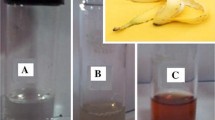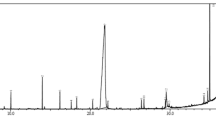Abstract
In-vitro free radical scavenging activity of biosynthesized gold (Au-NPs) and silver (Ag-NPs) nanoparticles was investigated in the present study. Natural precursor Prunus armeniaca (apricot) fruit extract was used as a reducing agent for the nanoparticle synthesis. The free radical scavenging activity of the nanoparticles were observed by modified 1,1′-diphynyl-2-picrylhydrazyl, DPPH and 2,2′-azinobis (3-ethylbenzothiazoline-6-sulfonic acid), ABTS assay. The synthesized nanoparticles were characterized by UV–Visible spectroscopy, dynamic light scattering, transmission electron microscopy (TEM), X-ray diffraction (XRD), energy dispersive spectroscopy, and fourier transform infrared spectroscopy (FTIR). Appearance of optical absorption peak at 537 nm (2.20 keV) and 435 nm (3 keV) within 0.08 and 0.5 h of reaction time was confirmed the presence of metallic Au and Ag nanoclusters, respectively. Nearly spherical nanoparticles with majority of particle below 20 nm (TEM) for both Au-NPs and Ag-NPs were synthesized. XRD pattern confirmed the existence of pure nanocrystalline Au-NPs while few additional peaks in the vicinity of fcc silver-speculated crystallization of metalloproteins of fruit extract on the surface of the Ag-NPs and vice versa. FTIR spectra was supported the role of amino acids of protein/enzymes of fruit extract for synthesis and stabilization of nanoparticles. Dose-dependent scavenging activity was observed for Au-NPs and Ag-NPs in both DPPH and ABTS in-vitro assay. 50 % scavenging activity for DPPH were 11.27 and 16.18 mg and for ABTS 3.40 and 7.12 mg with Au-NPs and Ag-NPs, respectively.









Similar content being viewed by others
References
Ankamwar B, Damle C, Ahmad A, Sastry M (2005) Biosynthesis of gold and silver nanoparticles using Emblica officinalis fruit extract, their phase transfer and transmetallation in an organic solution. J Nanosci Nanotechnol 5:1665–1671
Banerjee J, Narendhirakannan RT (2011) Biosynthesis of silver nanoparticles from Syzygium cumini (L.) seed extract and evaluation of their in vitro antioxidant activities. Dig J Nanomater Biostruct 6:961–968
BarathManiKanth S, Kalishwaralal K, Sriram M, Pandian SRK, Youn HS, Eom SH, Gurunathan S (2010) Anti-oxidant effect of gold nanoparticles restrains hyperglycemic conditions in diabetic mice. J Nanobiotechnol 8:16–30
Deivanayagam CN, Krishnarajasekhar OR, Ravichandran N (2001) Evaluation of Siddha medicare in HIV disease. J Assoc Physicians India 49:390–391
Dubey SP, Lahtinen M, Sillanpaa M (2010) Tansy fruit mediated greener synthesis of silver and gold nanoparticles. Process Biochem 45:1065–1071
Ghodake G, Eom C-Y, Kim SW, Jin ES (2010) Biogenic nanosynthesis; towards the efficient production of the biocompatible gold nanoparticles. Bull Korean Chem Soc 31:2771–2775
Jain D, Daima HK, Kachhwaha S, Kothari SL (2009) Synthesis of plant-mediated silver nanoparticles using papaya fruit extract and evaluation of their anti microbial activities. Dig J Nanomater Biostruct 4:557–563
Kasthuri J, Kathiravan K, Rajendiran N (2009) Phyllanthin-assisted biosynthesis of silver and gold nanoparticles: a novel biological approach. J Nanopart Res 11:1075–1085
Kattumuri V, Katti K, Bhaskaran S, Boote EJ, Casteel SW, Fent GM, Robertson DJ, Chandrasekhar M, Kannan R, Katti KV (2007) Gum arabic as a phytochemical construct for the stabilization of gold nanoparticles: in vivo pharmacokinetics and X-ray-contrast-imaging studies. Small 3:333–341
Konwarh R, Gogoia B, Philip R, Laskar MA, Karaka N (2011) Biomimetic preparation of polymer-supported free radical scavenging, cytocompatible and antimicrobial green silver nanoparticles using aqueous extract of Citrus sinensis peel. Colloid Surf B 84:338–345
Nadworny PL, Wang JF, Tredget EE, Burrell RE (2008) Anti-inflammatory activity of nanocrystalline silver in a porcine contact dermatitis model. Nanomedicine 4:241–251
Navarro M, Perez H, Sanchez-Delgado RA (1997) Towards a novel metal-based chemotherapy against tropical diseases. 3. Synthesis and antimalarial activity in vitro and in vivo of the new gold–chloroquine complex [Au(PPh3)(CQ)]PF6. J Med Chem 40:1937–1939
Prathnaa TC, Chandrasekarana N, Raichurb AM, Mukherjeea A (2011) Biomimetic synthesis of silver nanoparticles by Citrus limon (lemon) aqueous extract and theoretical prediction of particle size. Colloids Surf B 82:152–159
Raghunandan D, Ravishankar B, Sharanbasava G, Mahesh DB, Harsoor V, Yalagatti MS, Bhagawanraju M, Venkataraman A (2011) Anti-cancer studies of noble metal nanoparticles synthesized using different plant extracts. Cancer Nano 2:57–65
Rajakumar G, Rahuman AA (2011) Larvicidal activity of synthesized silver nanoparticles using Eclipta prostrata leaf extract against filariasis and malaria vectors. Acta Trop 118:196–203
Rogers JV, Parkinson CV, Choi YW, Speshock JL, Hussain SM (2008) A preliminary assessment of silver nanoparticle inhibition of Monkeypox virus plaque formation. Nanoscale Res Lett 3:129–133
Serpen A, Capuana E, Fogliano V, Gokmen V (2007) New procedure to measure the antioxidant activity of insoluble food components. J Agric Food Chem 55:7676–7681
Shankar SS, Rai A, Ahmad A, Sastry M (2004) Rapid synthesis of Au, Ag, and bimetallic Au core-Ag shell nanoparticles using neem (Azadirachta indica) leaf broth. J Colloid Interf Sci 275:496–502
Singhal G, Bhavesh R, Kasariya K, Sharma AR, Singh RP (2011) Biosynthesis of silver nanoparticles using Ocimum sanctum (tulsi) leaf extract and screening its antimicrobial activity. J Nanopart Res 13:2981–2988
Tai Y, Tran NTT, Tsai YC, Fang JY, Chang LW (2011) One-step synthesis of highly biocompatible multi-shaped gold nanostructures with fruit extract. IET Nanobiotechnol 5:52–59
Tsai CY, Shiau AL, Chen SY, Chen YH, Cheng PC, Chang MY, Chen DH, Chou CH, Wang CR, Wu CL (2007) Amelioration of collagen-induced arthritis in rats by nanogold. Arthritis Rheum 56:544–554
Acknowledgments
Authors are thankful to the Sophisticated Analytical Instrument Facility (SAIF), IIT Bombay and Electrical Research and Development Association (ERDA) Varodara, for providing the research facility for characterizations of samples.
Author information
Authors and Affiliations
Corresponding author
Additional information
This article is part of the topical collection on nanomaterials in energy, health and environment
Rights and permissions
About this article
Cite this article
Dauthal, P., Mukhopadhyay, M. In-vitro free radical scavenging activity of biosynthesized gold and silver nanoparticles using Prunus armeniaca (apricot) fruit extract. J Nanopart Res 15, 1366 (2013). https://doi.org/10.1007/s11051-012-1366-7
Received:
Accepted:
Published:
DOI: https://doi.org/10.1007/s11051-012-1366-7




